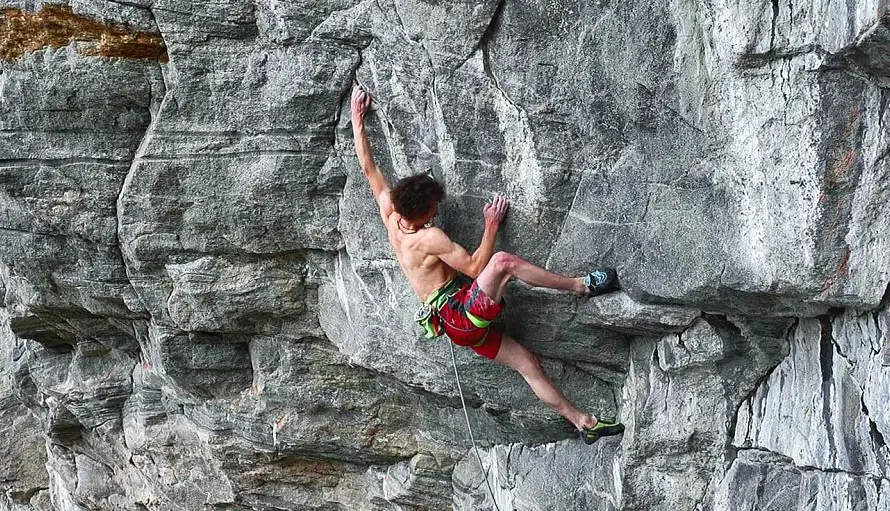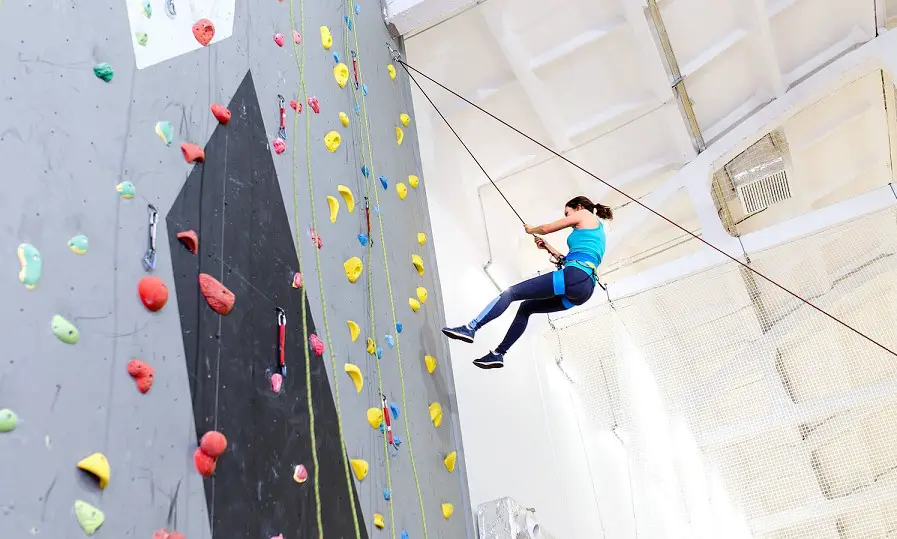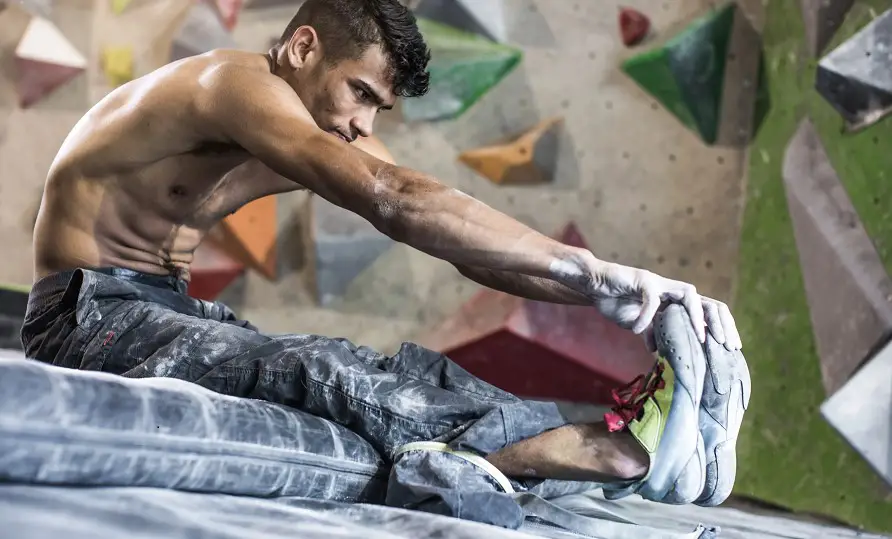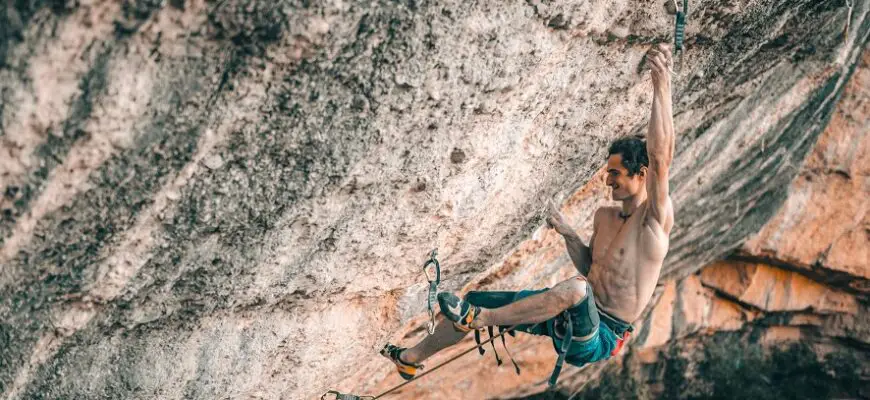There are probably a few worries that pop into your head as soon as you decide to start sport climbing.
For any beginner rock climber out there who is just starting to pursue an interest in the sport, we have done the required study and have come up with some advice and pointers.

- Is rock climbing beginner-friendly?
- Is learning to rock climb hard?
- Do you need to be strong to rock climb?
- Hand grip
- Core strength
- Flexibility
- Cardiovascular health
- Can someone with a disability rock climb?
- Is rock climbing hard the first time?
- Indoor rock climbing: the best place to start climbing
- Top-rope climbing walls
- Bouldering
- Lead climbing
- Embrace support from experienced climbers
- Guiding service
- How to dress properly for indoor climbs
- How can I make climbing easy for my first time?
- Have a positive mindset!
Is rock climbing beginner-friendly?
Rock climbing is thrilling to watch and do, but it can also be a little daunting to watch if you haven’t really started or viewed it for the first time. We are aware that many people were first intimidated by the idea of learning sport climbing in a public place like a gym.
The reputation of gyms as places that are welcoming to learners isn’t the best.
However, climbing gyms are distinct from conventional gyms, and you can meet many amiable sports climbers who are willing to assist and impart knowledge. Still, how challenging is rock climbing? Although the question is vague and devoid of specifics, we will make an effort to respond to it in this post.
Is learning to rock climb hard?
Rock climbing has evolved over the past ten years from a niche adventure sport to a more popular pastime. Beginners may find any sport scary, but rock climbing may seem especially difficult because it requires leaving the security of the ground.
In addition, a novice climber may find climbing to be considerably more challenging because of the extensive use of equipment unique to rock climbing, such as ropes and harnesses.
If you can climb a ladder, you can certainly go rock climbing. Rock climbing is not difficult for novices. The difficulty of climbing routes and bouldering challenges ranges from easy to very challenging. Start with a simple task in your comfort zone, then work to get better at it.
Rock climbing demands talent, strength, and practice to get better, just like any other sport. Rock climbing, on the other hand, is accessible to everyone — even those who have never attempted a sport before — unlike some sports where a certain amount of strength or athleticism is required to have fun as a novice!
Continue reading to find out why climbing can be simple for beginners and how to prepare for your first climbing experience.
Do you need to be strong to rock climb?
You must ensure that your body is capable of the task before starting any kind of rock climbing. Rock climbing is not for the faint of heart and will put a lot of strain on your muscles and joints. These workouts may be taxing and tax your body to the maximum, but they are necessary for every novice climber.
As long as you are prepared, learning to climb is not difficult. It is advised that a novice climber perform these workouts twice a day for two full weeks before the first climb. You’ll be on your way to your first climb in no time if you follow their advice.
Hand grip
When starting out, many novice climbers find that using a hand gripper is really beneficial. It is advised to start with 15-minute hand gripper exercises and squeeze each hand 50 times daily.
Core strength
The next step is to make sure your core body strength is sufficient to maintain your torso as close to the climbing wall as possible. For beginners, many trainers advise planks, bridges, or even leg circles. Your abdominal strength will significantly increase as a result of these workouts in a relatively short period of time.
Flexibility
Additionally, you should practice bending your joints and stretching your muscles. There are numerous ways to accomplish this. One choice is yoga. Nevertheless, some simple hip/shoulder/stretch motions and stretches might help to work your joints and increase your flexibility. Lunges and squats are also excellent exercises.
Cardiovascular health
Additionally, you must be sure that your heart and lungs can handle the strain. It’s normal to feel out of breath during the first few ascents, however exercising cardio before your climb will definitely minimize this. Early on in your training, you should start developing a solid cardio routine.
Can someone with a disability rock climb?
Yes! Many people without legs have made it up mountains. What routes work best for you simply depends on your unique handicap.
However, you can still climb slab routes even if your hands or fingers are missing.
Even if you feel that your impairment prevents you from doing anything, we believe you should give it a shot. There is a good probability that you will still have a great time!
Is rock climbing hard the first time?
Although rock climbing may appear to be an extreme activity, specialists use their climbing prowess to reach some extremely inhospitable and hazardous locations. Climbing, however, can be simple for novices for a variety of reasons.
The most challenging part for most beginners is the mental challenge of ascending high into the air and putting their trust in a rope to support or catch them. The natural fear of heights in humans can make it challenging to appreciate being airborne.
Imagine it as a roller coaster or even park swings to assist you to change your perspective. Enjoy the rush of adrenaline while letting your thoughts overcome your underlying fear.
Indoor rock climbing: the best place to start climbing
With an indoor wall or rock climbing gym, you can start climbing with one of the simplest methods possible. While many climbers are eager to try their transfer to outdoor climbing, it is always safer to climb on an indoor wall that is under close supervision.
These climbing gyms provide you with a more laid-back setting to start your rock climbing endeavors, and they frequently include staff members who are happy to show you around the wall.
Depending on the kind of wall you intend to climb, many climbing gyms may charge you differently. This shouldn’t stop you from starting your training in a gym, either. Just something to be aware of if money is a little tight.
After selecting a gym, you will frequently be presented with a variety of walls or courses to choose from.
Top-rope climbing walls
For a true beginner climber, top-rope climbing is a fantastic way to start. This will instruct you in the fundamentals of the sport and assist you in becoming accustomed to wearing a harness. The practice of top roping, in which your rope is fastened to an anchor above you, is another name for this.
You secure one end of the rope around yourself, and the other end will be fastened to keep you safe from an unplanned fall. These ropes may occasionally be held by an employee who will manually halt your fall, or you may even be able to ask a friend to help. Some elite gyms even include mechanical “belayers” that can detect falls and stop them automatically.
Even if something terrible happens to your trusted belayer or an automated belaying system, you may rest certain that, while the fall may hurt, you’ll probably be okay because practically every gym has a cushioned pad situated beneath the wall.

Bouldering
Both rock climbing and bouldering will do for beginners, although it can occasionally be a little trickier than top-rope climbing. Typically, there is no harness or rope to hold on to when bouldering.
A bouldering course is typically built close to the ground so that you won’t suffer significant injuries if you fall.
If you start to stumble or fall, you can ask for a spotter who can catch you, although it won’t always be necessary.
Bouldering is exactly what its name suggests: climbing boulders. Before tackling some of the more difficult rock climbing activities, bouldering is an excellent way to strengthen your upper and lower body. Many novices think it to be the most fun because it is much easier than top-roping.
Without the intricacy and safety issues of top roping or lead climbing, bouldering enables you to obtain a solid understanding of a rock climbing course.
Lead climbing
You might opt to switch to lead climbing once you’ve proven yourself as a climber. You must be fastened to a rope with a clip or carabiner at the other end to climb in this manner. You will climb the wall in an enclosed space while transferring your carabiner from bolt to bolt.
Once again, you’ll need a belayer for lead climbing. Although this is undoubtedly one of the riskier types of rock climbing, the chance of harm is small in a gym environment. Because a fall would usually hurt pretty badly, lead climbing is regarded as one of the more challenging climbs.
At every gym, safety measures are undoubtedly taken to prevent serious injuries. Lead climbing is difficult, though, due to the elevated danger of injury and the extreme stress it will put on your upper-body muscles.
The most comparable indoor climbing to outdoor climbing, according to many climbers, is lead climbing. Making sure you don’t slip while lead climbing is the real challenge. In most cases, you’ll be fastened to several bolts, so even if you fall, you won’t go very far. The fall, however, is far more difficult than top-roping.
Embrace support from experienced climbers
Like outdoor climbing, indoor climbing has its set of difficulties. It’s essential to always keep in mind that rock climbing is not a competition. To begin with, the only goal of rock climbing is to challenge yourself without going too far.
Having fellow rock climbers nearby is therefore usually a good idea because they can keep an eye on you while you are climbing and vice versa.
However, there are frequently staff members at the gym who may assist if you don’t have a companion. Pay attention to their counsel and put it into action diligently. Since it’s their job, they are there to assist you.
Every day of their climbing career, these employees spend time training people just like you. They are knowledgeable about every aspect of rock climbing and are aware of all the ways you can enhance your performance.
Guiding service
Using guide services might make your first time incredibly simple if you wish to do your first climbing outdoors! While guiding services are pricier than using a gym, they can manage all the details of your first rock climbing routes.
In terms of safety, grade ranges, and equipment, guides can offer an experience similar to that of a gym, but in the more thrilling setting of an outdoor setting. Additionally, nothing compares to the feeling of reaching the summit of an outdoor climb and admiring the scenery!
How to dress properly for indoor climbs
Although many beginners may find rock climbing challenging, adopting the right equipment will make your journey as easy as possible. For a successful climb, you’ll need a few essential supplies. They include appropriate attire, rock climbing shoes, a harness, a locking carabiner, climbing ropes, and climbing chalk.
- You must try on many outfits when choosing climbing gear to find an item that is both comfy and appropriate for you. You need to be able to move about comfortably, but your attire shouldn’t be too loose. Numerous instructors advise donning yoga attire since it is form-fitting but incredibly flexible.After a few climbs, your clothes will probably be quite dirty, so make sure you aren’t wearing something that is really significant. Otherwise, you might be irritated by all the chalk and dirt marks that a climb can leave on your clothing.
- One of the most crucial pieces of your equipment is undoubtedly your harness. Harnesses are frequently sized-adjustable and can be used for both indoor and outdoor climbing. Just be sure to select a harness that fits comfortably, similar to how your clothes should.
- Another component of your climb that you need is a locking carabiner. But, it’s uncommon to be able to simply walk into your neighborhood grocery store and pick up an inexpensive carabiner off the shelf. They typically can’t handle the pressure and weight that you’ll be applying to them.It’s typically advisable to purchase a decent carabiner from a sports goods store or even online. Although high-quality carabiners can be pricey, you must keep in mind that your life will be in its hands. Make sure you invest in a high-quality carabiner.
- Ropes are typically provided by the gym you are visiting. This is done to minimize any liability concerns that can arise from a climber using a poor quality or old rope. Although they are rather uncommon, some gyms ask you to provide your own rope.
- Similar to gymnastics, chalk is only used to keep your hands dry and free from moisture, sweat, and debris. Moreover, you’ll need a chalk bag, so you may reapply chalk as necessary during your climb.
- The last thing you need to do is spend money on a quality pair of rock climbing shoes. The cost of these shoes can typically vary greatly between brands; therefore the most crucial thing is typically to simply choose a shoe that fits you comfortably and doesn’t give you any discomfort.Several sporting goods stores will assist you to select a pair of shoes that will work best for you, so don’t be frightened if you’re having problems. Even forums exist to assist you in locating the ideal footwear for your needs and your intended climbing routes.
How can I make climbing easy for my first time?
The hardest part of learning a new skill is actually putting it into practice for the first time. Don’t be afraid to begin climbing! Here are a few strategies to make your first climbing experience enjoyable and simple.
- Learn climbing grades
Both outdoor and indoor climbing routes employ grading systems to indicate the difficulty of the route to the climber. Most gyms will prominently display these grades at the beginning of each route. Here is a summary of the American grading systems in use:
- V-Scale: This bouldering grading system ranges in difficulty from V0 to V17. The route is easier the lower the number that crosses the “V.” For instance, V1 is simpler than V2.
- YDS: This grading scale, which ranges from 5.0 to 5.15d, is used for roped climbing. The first number, “5”, denotes the route’s steepness and signifies “5th class.” This amount won’t ever change!The numbers that follow the decimal point indicate how challenging that fifth-class route is. The route is easier the lower the number after the decimal. For instance, 5.9 is simpler than 5.10
- Bring a friend
When attempting something new, a companion is always a wonderful thing to have! Ask your regular workout partner whether they might be interested in trying a different sport if you have one. This will make it easier for you to exercise and give it your all in a setting that is otherwise unfamiliar.
- Warm-up by stretching
Even though the majority of gyms offer climbs that are accessible and frequently simple for novices, it’s crucial to prepare your body for a new type of workout.
While doing something for the first time, even something as simple as climbing a ladder repeatedly might leave you sore.
Although climbing works every muscle in the body, when you first start climbing, your upper body muscles will likely experience the most strain. Before climbing, during, in between, and after your session, extend your shoulders, triceps, biceps, and forearms.
- Prepare your mind
For beginners, the most challenging aspect of climbing is frequently the mental rather than the physical one. Knowing what to expect can make overcoming these difficulties much easier. Various types of climbing provide different mental hurdles.
Learn to believe in the tools. You and ten of your closest friends can be lifted thanks to a climbing rope. The carabiners and harness are immovable. Sorry, but the machinery is rock-solid! By hanging from the rope a few feet off the ground and practicing short practice falls, you can learn to trust it.
You can ascend between 30 and 60 feet when top-rope climbing! If you’re terrified of heights, climb the wall gradually and descend if your fear gets the better of you. You’ll gradually feel more at ease climbing higher after you’re more accustomed to climbing and how everything works!
Although you don’t rise very far off the ground when bouldering, there is no safety rope to catch you if you fall. Practice jumping off the bouldering wall and landing safely while remaining near the ground to get over your fear of falling.
You will feel more at ease bouldering all the way up the wall once you are familiar with the mechanics of good falling and landing techniques.

Have a positive mindset!
Climbers should live by this principle, especially if they are just starting out. Even if climbing initially seems more difficult than you anticipated, the most essential things you can do are to have a positive attitude, give it your all, and have fun. Climbing can be pleasurable whether you are climbing something easy or challenging.
Also Read About: Rock Climbing VS Bouldering










